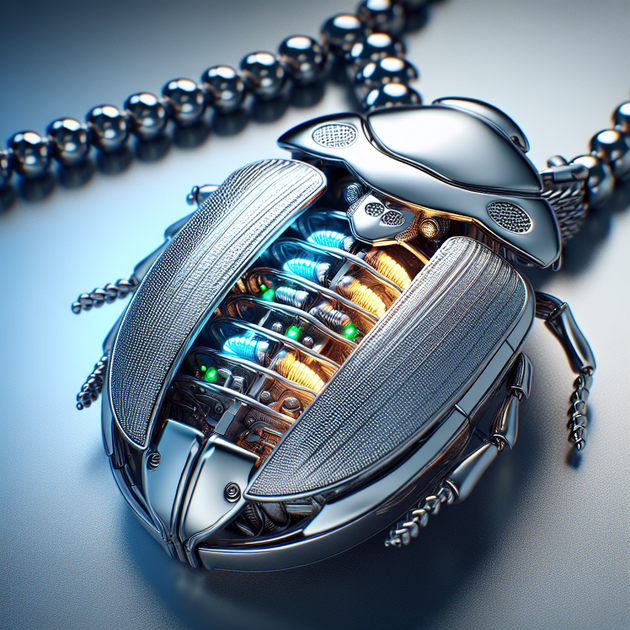Ever thought your jewelry could sense when someone’s standing close? That’s exactly what this interactive mechatronic necklace does—it doesn’t just sit pretty; it comes alive.
What Makes This Mechatronic Necklace So Unique?
At first glance, this might look like a beautifully crafted beetle pendant. But there’s way more going on under the surface. The creator blended lost wax casting in sterling silver for the beetle’s body with resin-printed parts for intricate details. But what really sets this piece apart is its built-in electronics—the heart of any true mechatronic necklace.
Inside the thorax is a tiny thermal camera. It’s not just along for the ride; it actively communicates with an Arduino Nano 33 BLE. When someone gets close enough to the wearer, things start happening:
- The shell pieces open up using three micro servos (one for each outer shell and one for the antenna).
- LEDs inside the abdomen light up in random colors.
- The closer someone moves in, the more “agitated” the beetle appears—the LEDs shift from rainbow to yellow to red.
- The antenna moves faster as proximity increases.
It’s not just about looking cool (though it absolutely does); it’s about creating an interactive experience between wearer and observer.
The Tech Behind the Interactive Jewelry
Let’s break down those smart features:
– Thermal Camera: Hidden in the beetle’s thorax, this sensor detects body heat nearby.
– Arduino Nano 33 BLE: The brain of the operation processes proximity data from the camera.
– Micro Servos: These tiny motors control both the opening shells and moving antennae.
– LED Lighting: Programmed to shift color according to distance—adding both drama and personality.
For anyone curious about how wearable electronics like these are designed or want inspiration for their own DIY tech projects, there are lots of resources out there. For example, sites like Hackster.io feature projects where makers blend microcontrollers with fashion or jewelry.
How Proximity Detection Works in Wearable Electronics
The magic trick here is using a thermal camera instead of standard sensors like infrared or ultrasonic. When another person walks closer to the necklace’s wearer, their body heat is detected by the camera module. The Arduino interprets those signals and triggers two main responses:
- The servo motors open up the beetle’s shell panels and move its antennae at variable speeds.
- The internal LEDs swap colors from playful hues to warning reds depending on how close someone gets.
This kind of interaction isn’t just fun—it could have applications in personal space awareness or even future social wearables. If you’re curious about how thermal cameras work in general or want deeper tech details on sensors like these, check out this overview from FLIR, a leader in thermal imaging.
Anecdote: From Idea to Finished Project
The whole build took a blend of skills—not just electronics but also metalwork and design. The creator started out wanting something “weird but super fun.” Between learning lost wax casting (to create that lifelike beetle body) and tackling resin printing for detailed components, there were plenty of late nights spent troubleshooting electronics too. According to their detailed project video (linked on YouTube), tweaking servo positions was especially tricky—one wrong angle and the shells wouldn’t open smoothly. But seeing everything finally come together—the shells fluttering open as someone approached—made all those test runs worthwhile.
Why Combine Art With Robotics?
Projects like this mechatronic necklace show just how much overlap there can be between art and technology. By bringing together classic jewelry-making techniques with modern microcontrollers and sensors, makers can create pieces that surprise—and sometimes even unsettle—in all the best ways.
If you’ve ever wanted to start your own project that mixes wearable tech with traditional crafts—even something as simple as adding LEDs to clothing—there are tons of beginner guides out there (Adafruit has some great tutorials on their Wearables Learning System). You might be surprised how accessible it is once you break things down into smaller steps.
Inspiration for Your Next DIY Tech Adventure
If making an interactive mechatronic necklace sounds wild but exciting—or maybe even a little intimidating—remember: every complex project starts with one small idea (and probably a bit of trial-and-error!). What kind of wearable gadget would you build if there were no limits?

Leave a Reply